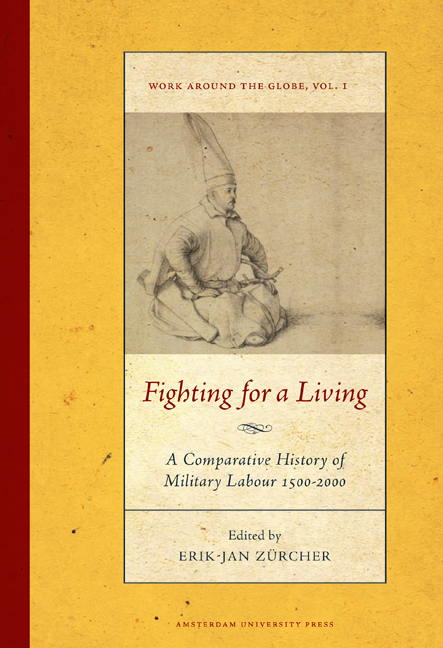Book contents
- Frontmatter
- Dedication
- Contents
- Preface
- Introduction: Understanding Changes in Military Recruitment and Employment Worldwide
- Military Labor in China, c. 1500
- From the Mamluks to the Mansabdars: A Social History of Military Service in South Asia, c. 1500 to c. 1650
- On the Ottoman Janissaries (Fourteenth-nineteenth Centuries)
- Soldiers in Western Europe, c. 1500-17901
- The Scottish Mercenary as a Migrant Labourer in Europe, 1550-1650
- Change and Continuity in Mercenary Armies: Central Europe, 1650-1750
- Peasants Fighting for a Living in Early Modern North India
- “True to Their Salt”: Mechanisms for Recruiting and Managing Military Labour in the Army of the East India Company During the Carnatic Wars in India
- “The Scum of Every County, the Refuse of Mankind”: Recruiting the British Army in the Eighteenth Century
- Mobilization of Warrior Populations in the Ottoman Context, 1750-1850
- Military Employment in Qing Dynasty China
- Military Service and the Russian Social Order, 1649-1861
- The French army, 1789-1914: Volunteers, Pressed Soldiers, and Conscripts
- The Dutch Army in Transition: From All-volunteer Force to Cadre-militia Army, 1795-1830
- The Draft and Draftees in Italy, 1861-1914
- Nation-building, War Experiences, and European Models: The Rejection of Conscription in Britain
- Mobilizing Military Labor in the Age of Total War: Ottoman Conscription Before and During the Great War
- Soldiering as Work: The All-volunteer Force in the United States
- Private Contractors in War From the 1990s to the Present: A Review Essay
- Collective Bibliography
- Notes on Contributors
From the Mamluks to the Mansabdars: A Social History of Military Service in South Asia, c. 1500 to c. 1650
Published online by Cambridge University Press: 12 December 2020
- Frontmatter
- Dedication
- Contents
- Preface
- Introduction: Understanding Changes in Military Recruitment and Employment Worldwide
- Military Labor in China, c. 1500
- From the Mamluks to the Mansabdars: A Social History of Military Service in South Asia, c. 1500 to c. 1650
- On the Ottoman Janissaries (Fourteenth-nineteenth Centuries)
- Soldiers in Western Europe, c. 1500-17901
- The Scottish Mercenary as a Migrant Labourer in Europe, 1550-1650
- Change and Continuity in Mercenary Armies: Central Europe, 1650-1750
- Peasants Fighting for a Living in Early Modern North India
- “True to Their Salt”: Mechanisms for Recruiting and Managing Military Labour in the Army of the East India Company During the Carnatic Wars in India
- “The Scum of Every County, the Refuse of Mankind”: Recruiting the British Army in the Eighteenth Century
- Mobilization of Warrior Populations in the Ottoman Context, 1750-1850
- Military Employment in Qing Dynasty China
- Military Service and the Russian Social Order, 1649-1861
- The French army, 1789-1914: Volunteers, Pressed Soldiers, and Conscripts
- The Dutch Army in Transition: From All-volunteer Force to Cadre-militia Army, 1795-1830
- The Draft and Draftees in Italy, 1861-1914
- Nation-building, War Experiences, and European Models: The Rejection of Conscription in Britain
- Mobilizing Military Labor in the Age of Total War: Ottoman Conscription Before and During the Great War
- Soldiering as Work: The All-volunteer Force in the United States
- Private Contractors in War From the 1990s to the Present: A Review Essay
- Collective Bibliography
- Notes on Contributors
Summary
Introduction
By the first decade of the sixteenth century, the Delhi Sultanate (1206-1526), the dominant power in north India, was breaking up. Several autonomous states emerged to challenge the political supremacy of the Delhi Sultanate in the Ganga-Jamuna doab (the fertile tract of land between the rivers Ganga and Jamuna in north India). Deccan (the region between the rivers Godavari and Krishna) and south India had become independent of the Delhi Sultanate's control earlier during the mid-fourteenth century. The invasion of India by the Turkish warlord Zahir-ud-din Muhammad Babur in 1526 resulted in the replacement of the Lodi dynasty ruling the Delhi Sultanate with the Mogul Empire. The Moguls (Mughals; the nineteenth-century British officials and historians called them Moghuls) referred to themselves as Chagatai Turks or Timurids even though their family links with the Chagatai branch of the Chingizids were weak. The Moguls claimed that from their father's side they descended from Amir Timur and from their mother's side from the Chagatai Mongol branch. The newly born Mogul Empire was overthrown in 1540 by the Afghan warlord from east India named Sher Shah Suri. Babur's son Humayun staged a comeback in 1555.
The “real” founder of the Mogul Empire was indeed Akbar (Padshah, i.e. emperor, from 1556 to 1605). Akbar put an end to the political chaos in north India by subduing the Afghans and the Rajputs. Further, he reorganized the administration. By the time of Akbar's death in 1605, the Mogul Empire had established a stable administrative machinery in north and central India and was in the process of moving slowly into Deccan. Until the fourteenth century, the dominant mode of military recruitment in India was the mamluk system. The mamluks were slave soldiers of the Muslim world. However, by the end of the sixteenth century, due to Akbari reorganization, a sort of quasi-mercenary-cum-quasi-professional military employment known as the mansabdari system became dominant. The beginning of the seventeenth century witnessed the gradual expansion of Mogul power into Deccan under Akbar's son and grandson, named Jahangir (r. 1605-1627) and Shah Jahan (r. 1628-1658) respectively. They continued to operate within the administrative fabric established by their illustrious predecessor.
- Type
- Chapter
- Information
- Fighting for a LivingA Comparative Study of Military Labour 1500–2000, pp. 81 - 114Publisher: Amsterdam University PressPrint publication year: 2013
- 17
- Cited by



